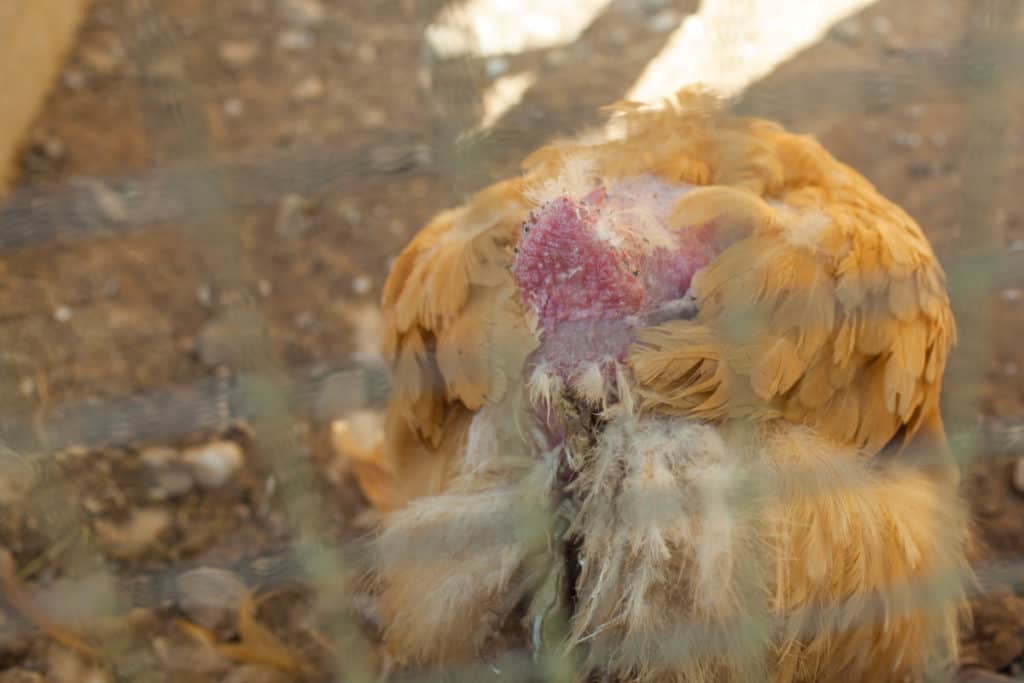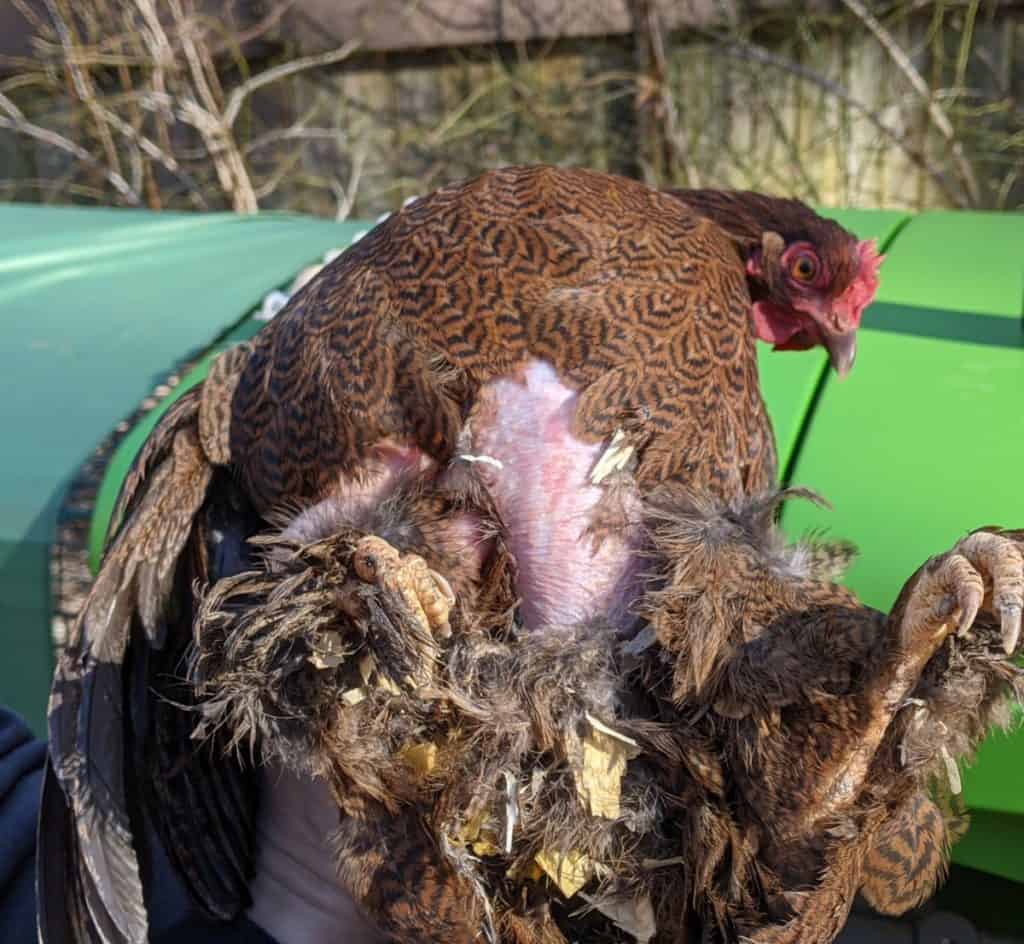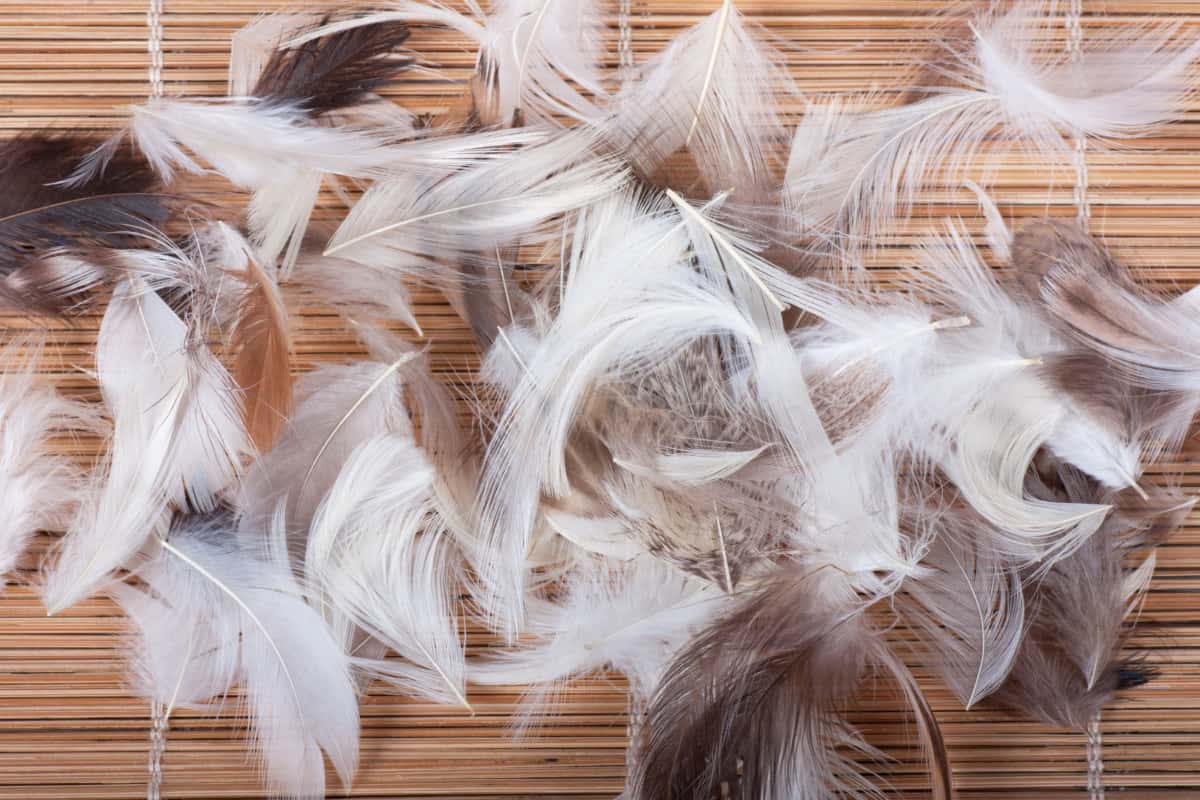A bare chicken is not a pretty sight, and it can be alarming to see your fluffy hens with less than their average amount of feathers. It is always wise to investigate changes in your chicken’s appearance.
The truth is there are many reasons for feather loss in chickens, and you need to determine whether it is a sinister cause or a natural cause.
Chickens lose their feathers due to molting, which is a natural process. Nesting hens may pluck feathers to line their nests. Mites, lice, stress, and disease cause feather loss. Behavioral issues such as vent pecking and over-mating can cause feather loss.
Understanding the reason for feather loss in your chickens helps you decide what action needs to be taken.
- Chickens lose feathers due to a predator attack
- Feather Loss due to disease, parasites, and poor nutrition
- Feather Pecking
- Feather Loss In Chickens From Plucking
- Over-Mating Can Cause Feather Loss In Chickens.
- Broody Hens exhibit feather loss
- Preening Causes Feather Loss
- Feather loss due to Molting
- Why Does My Chicken Have No Feathers On Her Bottom?
- Conclusion
Chickens lose feathers due to a predator attack
If you notice a pile of feathers on the ground you better count your flock quickly there is a good chance a hawk, dog, raccoon, or other animal could have gotten one.
My chickens have dealt with hawks several times and there is always a pile of feathers on the ground afterward. Luckily my current flock has survived due to the protection of our roosters.

Feather Loss due to disease, parasites, and poor nutrition
Chickens may eat feathers due to insufficient protein in their diet. They also can lose feathers due to sickness or disease.
When chickens get mites or lice these parasites will accumulate in certain areas such as around the vent which is moist or shafts of feathers. In an attempt to get rid of them, your chicken will scratch and pull out her own feathers.
Feather Pecking
Feather pecking is a significant poultry behavior problem. All types of poultry birds are characterized by a social hierarchy. Poultry birds usually feather peck when they are stressed or there is poor management in the poultry farm.
Regardless of the production system, including free-range systems, pecking occurs more often in birds raised on the floor and in large free-range systems.
Feather Loss In Chickens From Plucking
Sometimes chickens pluck out their feathers. Nesting hens will pluck feathers, usually from their chests, to line their nest. This behavior will discontinue once the chicks have hatched.
If a chicken is self-mutilating and plucking feathers, this is probably a result of stress. The environment may be unsuitable. Crowding and lack of enough space for the flock can be a cause of feather plucking. The solution is to change the environment and reduce stress. Add a good vitamin supplement to the feed.
Over-Mating Can Cause Feather Loss In Chickens.
Roosters are sometimes too enthusiastic in their pursuit of the hens. If they mate too often or have large spurs, they damage the feathers on the hen’s back. These feathers fall out and leave bald spots on the back.

Broody Hens exhibit feather loss
When a broody hen has settled into a new nest she plucks feathers from her breast and puts them in the nesting area. This helps keep the eggs close to her skin while she’s incubating eggs and will give newly hatched chicks a place to rest on nice downy feathers.
Preening Causes Feather Loss
Preening is a natural chicken grooming behavior, and chickens lose feathers when they groom themselves. Preening helps keep the feathers in good condition by spreading oil from a gland located at the tail’s base. Chickens also remove any parasites they find, such as ticks.
Preening will not result in bare patches on the chicken, but you may be surprised by the number of feathers you see in the coop. Preening does not require any intervention. It is a sign of a healthy chicken.
Feather loss due to Molting
Chickens molt as a natural way of renewing their feathers and preparing for seasonal change. Molting is necessary as feathers get broken and dirty, which affects their ability to protect and warm the chicken.
Chicks have their first molt at six to eight days when they lose their baby down and acquire tiny feathers.
There is a second juvenile molt at eight to twelve weeks when larger feathers replace the baby feathers.
When Do Chickens Molt?
Adult chickens usually molt for the first time at sixteen to eighteen months. Molting in adult chickens occurs once a year and is triggered by declining daylight hours. Molting season is, therefore, usually fall. A new feather is called a pin feather as it grows in.
Do Chickens Get Cold When They Molt?
A hard molt occurs when the chicken loses the majority of its feathers at once and looks very bald. A soft molt is more common as there is less risk to the bird. In a soft molt, the feathers are lost consecutively so that the bird is never bald. The result is that the chickens can have bald spots and look tatty until all their feathers have been molted and replaced.
Chickens that undergo a hard molt will get cold as they have minimal feathers to keep them warm. You can help these bald chickens by ensuring you have a good layer of warm, clean bedding in their coops. If your bird has had an unusually timed hard molt in the depths of winter, then you may need to make alternative plans to keep the chicken warm.
How Long Does Molting Take?
In most chickens, molting occurs over three to four weeks. Each bird has an individual metabolism, and some chickens may take eight to twelve weeks to complete a molt. Climate and feed quality will also influence the length of the molt.

How Do You Know If A Chicken Is Molting Or Has Mites?
Mites make chickens itchy. There will be feather loss as the bird will preen or scratch excessively and damage the feathers or even pluck them out. If your chicken has pale, anemic comb and wattles, it is more likely to be mites or lice causing the feather loss.
The skin will probably be red and irritated, which is not seen during molting. You may be able to see the mites and lice if you examine the chicken under the wings and around the vent.
What Should I Feed My Chickens When They Are Molting?
Molting is a high-energy life task. Chickens require additional protein during molting to grow new feathers. Feathers consist of 85% protein, so it makes sense to increase the chicken’s protein intake. A lack of protein can delay feather regrowth.
How Do I Give My Chickens More Protein?
A simple way to supply more protein to chickens is to switch them to broiler food during molting. If you choose to use a more natural approach, you should include plant and animal proteins in the chicken feed mix.
Plants with high protein content include legumes such as peas, beans, and peanuts. Alfalfa and most seeds have a high protein content and should be added to the diet.
Animal proteins such as crickets, worms, bits of meat, and bonemeal can supplement the chicken’s diet.
Why Does My Chicken Have No Feathers On Her Bottom?
Vent gleet is a condition where the chicken has a yeast infection in the gastrointestinal or reproductive tract. This causes a yellowish or creamy colored discharge from the cloaca. The discharge damages the feathers, and the area around the vent becomes bald. The yeast infection needs to be treated to resolve this issue.
Vent pecking can also cause a lack of feathers around the vent. The vent or cloaca remains pink and swollen for some time after an egg is laid. If the other chickens spot this gleaming beacon of pink on the hen, they may peck at it and pull feathers out. It is a complex problem to resolve.
If the vent is being injured, then you may need to remove that hen until her vent is healed. Providing a constant supply of food during the morning when most eggs are laid can help distract the chickens and prevent them from paying too much attention to the swollen vent.
Conclusion
Pay close attention to your chickens so that you can decide if the feather loss is natural or pathological. This will allow you to determine the action you need to take. Providing a good diet and environment will help control abnormal feather loss.

